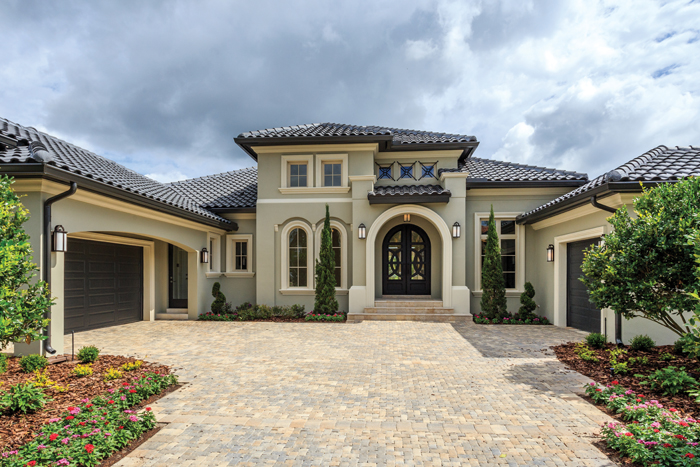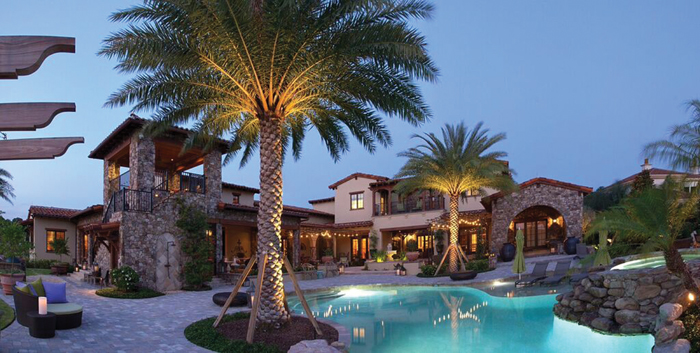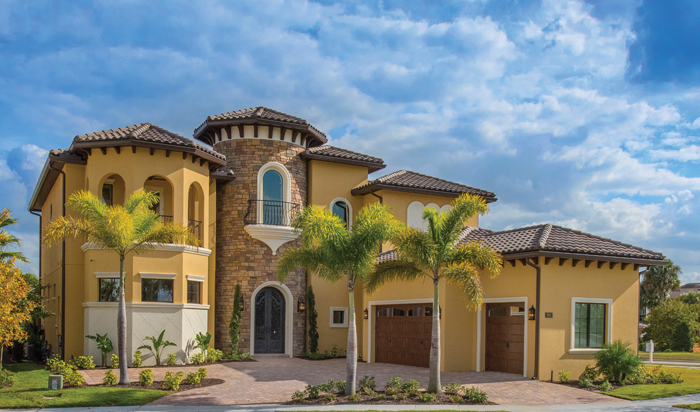
STONEBRIDGE HOMES
HAVE IT YOUR WAY
By Karen LeBlanc and Randy Noles
In 1922, Edwin Meredith gave contractors a gift that has kept on giving. He started a magazine called Fruit, Garden and Home, which two years later was renamed Better Homes and Gardens.
Before there was HGTV and Houzz, homeowners turned to Better Homes and Gardens for ideas and inspiration. Many other home-themed magazines followed, but Meredith’s was the first to tap into that innate desire shared by virtually everyone who pays a mortgage to have a home that truly reflects their personal style.
These days, most large production builders offer buyers latitude in “customizing” their homes with different fixtures and finishes, optional extra rooms and varying elevations. But, appealing as these homes may be, they’re still basically stock plans with dozens or perhaps thousands like them in subdivisions around the country.
Many buyers, especially high-income buyers, choose to build custom homes — meaning the homes are one-of-a-kind, built from original sets of plans. However, many custom builders also have portfolios from which buyers select basic plans and modify them.
In that case, is it still a custom home? Perhaps not by the strictest definition. “Semi-custom” may be a more appropriate term, depending upon the scope of the changes made to the portfolio plan.
“There’s been a specific definition of what a true custom home is,” says Jeff Schnellmann, chief operating officer of Orlando-based Silliman CitySide. “Some of us build inside that definition and some us build outside it. I would say the definition about what constitutes a custom home is broader these days.”
Indeed, some production builders are offering bigger homes and selling them at prices only custom builders could command 10 or 15 years ago. “They’re adding a tier to their product line that’s a bigger version of one of their models, and they’re positioning it as a custom home in the million-dollar-plus market,” says Greg Hardwick, owner of Maitland-based Hardwick General Contracting.
Still, there’s a difference. Custom builders are generally locally owned and operated, which means they can be far more flexible. And because they build only a handful of homes a year, they can offer the kind of lavish personal attention on their buyers that a national company can’t.
Regardless of definitions, building a custom home — whether it’s truly one-of-a-kind or uses a builder’s plan book as a starting point — is always going to be more complicated than picking a basic model offered by a production-home builder then selecting fixtures and finishes from a design center.
And, as with remodeling, the process requires considerable research and encompasses many potential pitfalls. (Watch Mr. Blandings Builds His Dream House, the 1940s Cary Grant and Myrna Loy comedy, and consider it to be a cautionary tale.)
In Orlando, some of the best custom builders are members of the Master Custom Builder Council (MCBC), a highly selective organization that requires its members to meet certain financial stability requirements as well as adhere to a rigid code of ethics.
Matt Trask, vice president of Sanford-based Dave Brewer Inc. and president of MCBC, says that builders who’ve been accepted for membership by the tight-knit organization have already undergone an extensive vetting process. However, he notes, some non-MCBC builders may simply not be joiners by nature, or may not wish to dedicate the time required to make the most of membership in a professional organization.
“Participation in organizations, such as MCBC, is one of many criteria you should consider in selecting a custom builder,” Trask says.
Florida Homebuyer Orlando interviewed some the region’s top custom builders about the process of creating a custom home — from conception to completion — and how to make certain everyone involved is happy with the result. Here’s what they had to say:
I understand the custom-home market is really on the upswing. Is that true? If so, how come?
Yes, like the rest of the building industry, the custom sector is making a strong comeback. But pent-up demand for custom homes is tempered by fewer available lots.
While most custom builders prefer to build in luxury new-home communities with lots of amenities, those situations are less common than they once were. So the custom contingent is also actively looking for infill opportunities in established areas.
“The market is limited by a lack of new, high-end communities; the recession stopped luxury developments,” says Derrick Koger, owner of Kissimmee-based Derrick Builders, which is building multimillion-dollar homes in Golden Oak at Walt Disney World Resort, where homes range in price from $3 million to $5 million.
“That’s a nice niche that Disney can provide,” says Koger. But beyond that unique situation, he doesn’t see any new Isleworth- or Lake Nona Country Club-type developments on the horizon.
Plus, deep-pocketed production builders have for years been stockpiling land so they’d be ready for the inevitable recovery. Over the past several years, their long-delayed master-planned communities have either gotten underway or expanded.
Custom homes — true custom homes — aren’t available in most such communities. “It’s becoming difficult to find available lots for custom homes because production builders have come back strong in the past few years, buying up and developing land,” says Jorge Ulibarri, owner of Longwood-based Cornerstone Custom Construction.
But Ulibari and others say they’re learning to like infill development, which usually involves tearing down an outdated home in a place like Winter Park, College Park, Maitland or any one of Central Florida’s more mature suburbs where the housing stock is aging.
“Building a custom home on an infill lot offers the beauty and ambiance of an established area with mature landscaping,” he says. “The challenge is complying with local building codes and restrictions, especially where neighbors are trying to prevent the construction of ‘McMansions’ that detract from the character of the neighborhood.”
Hardwick, who says 90 percent of his business is infill development, adds that overly conservative appraisals that hinder borrowing are a factor limiting growth in the custom-home arena.
“Appraisals don’t reflect the true value of personalized features in a custom home,” he says. “I think appraisers need to be better educated on assessing the value of new custom homes against resales or production homes.”
Dan Natoli, broker associate with Orlando-based Regal Real Estate Professionals, agrees.
“The appraisal process often provides obstacles to custom-home financing because appraisers won’t put in the time and effort to do them correctly,“ he says. “They can’t take a formulaic approach. They need to do the extra research.”
Despite the obstacles, adds Hardwick, “there are still people who demand custom homes — and these are the kind of people who want what they want.”
I’m one of those people! So I guess I need to find an architect first, right?
Not necessarily. Most custom builders can relate stories about buyers who show up with a full set of plans they’ve commissioned only to find that it’s impossible to build the home they envisioned at a reasonable cost.
“We actually prefer they don’t come to us with plans,” says Trask, who says it’s best to talk to the builder about what you want and need — and what your budget is — and work with a cohesive team from start to finish.
“It can be a nightmare,” adds Valery Tucker, president of Windermere-based Stonebridge Homes. Sometimes, Tucker and others say, clients show up with elaborate plans only to find that they can’t be built for anything close to what the client is willing to spend.
However, many architects and building designers — a building designer, by the way, is not an architect, but has been certified to design single-family homes — say they are quite adept at designing within the confines of a budget.
In any case, most custom builders don’t like to bid against one another on a set of pre-drawn plans. There are so many cost-impacting variables at play that it’s difficult to make apples-to-apples comparisons. Anyway, the lowest bid may be the costliest option in the long run — especially if the contractor is sub-par.
“If someone wants to get another price, okay,” says Trask. “But if it’s a competition with nine other builders in the mix, we’ll just pass.”
The best advice? Assemble a team and make sure everyone is on the same page — or the same blueprint, as it were. With so much money on the line, a team effort is mandatory.
Some builders describe themselves as “design-build” companies. What does that mean, exactly?
With a design-build contract — in which the builder drives the process from conception through construction — the architect is part of a team and reports to the builder, not to you.
A particularly hands-on owner may find that unappealing. The upside, however, is that a design-build contract offers a single point of contact and, arguably, tighter cost controls.
“There’s a personal connection required between the owner and the builder,” says Schnellmann. Trask agrees. “Our clients recognize and appreciate quality and personal service,” he says. “It’s like when buying a car, the difference in service you’ll get from a Ferrari dealer.”
Most custom builders either have their own architect or designer or have solid, long-term working relationships with the area’s top professionals. The consensus seems to be, go to the builder first.
While just showing up at a builder’s office with a set of plans might work out, you’re more likely to get a better result — and stick to your budget — when a cohesive team is assembled from the outset.
I’d love to build a custom home, but don’t they cost a lot of money compared to a production home?
Many — but not all — custom homes cost from the high six figures to more than $1 million, in large part because they’re bigger and feature upscale finishes and leading-edge technology.
Also, custom builders may build only a handful of homes each year, while production builders make their money on volume and replication. Not all custom homes are huge — some builders say they’ve built homes as small as 3,000 square feet, while others typically build in the 8,000-square-foot-plus range.
Most custom builders say they can build a home for between $180 and $230 per square foot, but there’s no average because each home is different — and each client has his or her costly quirks.
One person, for example, might spend tens of thousands of dollars on a specially designed spiral staircase. Another might insist that ceiling beams be salvaged from a barn in Vermont.
“Something like plumbing can also make costs go through the roof,” says Tucker. And while custom builders don’t forbid clients from shopping around and suggesting less expensive products they’ve discovered online, they very much doubt that you’ll happen upon something they’ve never heard of.
They also discourage clients from suggesting subcontractors. In the relatively small world of custom building, contractors generally have cultivated long relationships with their subs and know who’ll deliver quality work.
“We try to be flexible, but we usually say no,” says Trask. “We use our own subs.”
Even so, many custom homes come in over budget mainly because clients change their minds or think of something new that they simply can’t do without. “Beware of change orders, because they can quickly add up,” says Ulibarri. “Do your homework on the front end. Go through all of your finishes and specifications and make sure every item that you want in your home is included.”

CORNERSTONE CUSTOM CONSTRUCTION
What are some tips for selecting a custom builder?
It goes without saying — although we’re saying it — that any builder should have the proper state licenses. But the selection process goes far beyond that.
Nobody wants to be in the middle of a new-home project and have the builder go out of business. So, assuming you’re getting a construction loan, ask your banker to run a credit check on the builder you’re considering.
A builder with poor credit might not pay subcontractors, which would entail liens. Likewise, a builder with financial difficulties might lowball a job just to generate cash flow. MCBC members would have been checked out for financial stability, but it never hurts to do your own snooping.
Follow up on references, of course. But, naturally, no builder is going to suggest that you visit with an unhappy customer. You can search county permitting offices and see who’s built what — and then check out a sampling of those homes.
Having said all that, once you make up your mind, don’t drag your feet. Prices are going up as demand increases. That’s simple supply and demand. Land costs more, labor costs more, materials cost more.
“Waiting to close the deal will only add to the cost of your custom home,” says Ulibarri. “That’s one of the biggest mistakes that clients make in today’s marketplace. Clients need to be decisive and know what they want and move forward or expect price increases.
Personal rapport is also important. The custom builder will be part of the family for perhaps a year or more — and is spending a considerable sum of your money. You have to be comfortable communicating with him or her.
That doesn’t mean you automatically need to select the person you’d be most comfortable having a beer with — but you at least need to select someone who’ll listen and be responsive to your concerns.
Also, since most custom builders commit to only a handful of homes each year, find out how often he or she visits the job site. If the builder isn’t the on-site supervisor, then who is? Is that person also someone whose credentials and communications skills and impress you?
So what’s hot in custom homes?
Many of today’s custom homes look and feel quite different from those built 10 or 15 years ago, a number of which aimed for Mediterranean grandeur punctuated by ornate detailing and lofty spaces. (Most of the homes now derisively dubbed “McMansions” date from that era.)
Today’s clients want a home that accommodates all ages, stages and phases of their lives — a flexible home that works for children, aging parents and extended family.
“Nearly half of the homes we’re building are designed for multigenerational living, with an in-law suite or second master bedroom,” says Hardwick.
If the home is on a smaller lot — as many infill projects are — and the second master suite has to go upstairs, many clients are asking for elevators to make second-floor access easier, Hardwick says.
In the kitchen, clients want ergonomic appliances, pantries with pullout shelving, cabinets with motorized “touch to open” doors, more drawers and less upper cabinets so everything is low and accessible. Other popular features include corner pullouts and touch-activated faucets.
In the bathroom, no-threshold or curbless showers are becoming all the rage. Barn doors or pocket doors add style and easy access. Other popular features include frameless shower enclosures and the “Euro shower” concept, which provides a single space with a shower and tub.
Automation is also standard in most custom homes, providing remote-control capabilities for lighting, heating and cooling, audio-visual devices, home security and even windows and doors.
“Over the past five years, home-automation technology has come down in price and is easier to operate with app-driven, internet-enabled technology,” says Hardwick.
Transitional looks are supplanting once-popular Mediterranean and Tuscan influences. “Many of our clients are drawn to California-Laguna Beach style architecture with a lot of glass, natural light and courtyards,” says Koger.
“The marketplace in general is very bullish,” adds Natoli. “Even though we’re stabilizing, I think we are going to have another growth spurt over the next five years.”
Adds Tansey Soderstrom, broker/owner of The Real Estate Firm Orlando: “True custom homes are doing well. While we’re in a sellers’ market, for a little more money buyers can custom-build what they want.”

MCNALLY FINE CUSTOM HOMES
